Carved Marble Augustus of Prima Porta
Home » Inventory » Figural and Animal Statues » 05893 Carved Marble Augustus of Prima Porta
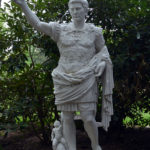
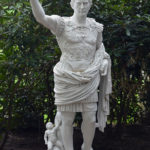
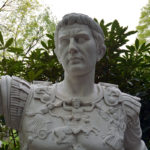
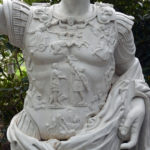
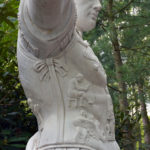
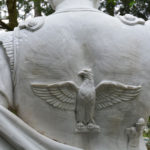
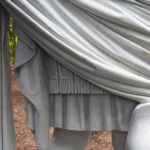
Carved Marble Augustus of Prima Porta
Item #05893
A carved marble figure of Augustus of Prima Porta, after the 1st-century AD Roman original, attributed to J. Chiurazzi & Fils, Italian (Naples), ca. 1900. 9 ft., 3 ins. overall height, 5 ft., 3 ins. overall width, 26 ins. overall depth.
The original Augustus of Prima Porta is one of the most celebrated examples of Imperial Roman sculpture. Housed in the Vatican Museum collection, it is thought to have been commissioned in 15 A.D. by Tiberius (42 B.C.-37 A.D.), as a memorial to his stepfather, Emperor Augustus (63 B.C.- 14 A.D.). It was discovered in 1863 in Prima Porta, just outside Rome, at the villa that had belonged to Augustus’ wife (and Tiberius’ mother), Livia (58 B.C.-29 A.D.). The marble statue may have been based on a bronze original of 20 B.C., although it is evident that Tiberius added details to the ceremonial armor that hadn’t been on the bronze. The central scene on the breastplate depicts a Parthian soldier surrendering the Eagle Standard to a Roman soldier. The Standard had been captured by the rival Parthians in 53 B.C.– a humiliating loss for Rome–and had been held for more than 30 years, with both Julius Caesar and Marc Antony trying and failing to reclaim it. The reclamation of the Standard in 20 B.C. is therefore considered one of Augustus’ premier achievements, and is heralded for being as much a diplomatic accomplishment as a military one. Indeed, securing the Standard was one of the key events leading to the stabilization of the Roman Empire. Thus, Tiberius’ inclusion of this scene on the marble figure is a reminder to all of his family’s strength and influence.
In addition to this central scene, Augustus’ armor displays a number of allegorical and mythical figures: Topmost on the front armor is the sky-god Caelus, with the sun-god Sol riding in a quadriga, a four-horse-drawn chariot, preceded by Aurora with a torch and the Morning Dew with a jug. Mother Earth, holding a cornucopia and garland of wheat, reclines with two cherubs below the main scene. On one side of the central scene are Apollo, with his lyre, riding a griffin, and Diana, with a torch, seated on a stag. On the other side are seated figures representing Roman provinces. On Augustus’ back is an eagle, and an unfinished scene. At Augustus’ feet is a figural group with a dolphin and winged cherub that evokes the sea-born Venus, calling to mind Venus Genetrix, an ancestor of the Imperial house.
Augustus is portrayed here as a general and as a hero, and by making him barefoot, is given godlike status. The general form of the statue, with traditional contrapposto pose, athletic build, and stylized hair, is borrowed from the revered Greek statue, the Doryphoros of Polykleitos, dating to 440 B.C.
The Chiurazzi firm was established in Naples in the 1870 by Gennaro Chiurazzi (1840-1906). In 1890, the Italian Ministry of Cultural Goods and Activities granted Chiurazzi the unprecedented opportunity to create molds of more than 1,500 important sculptures from elite Italian museums. With such an impressive collection of molds, the Chiurazzi firm became the world’s most prominent supplier of quality reproduction statuary.
Barbara says, “Suffice it to say this, this is one of the finest and grandest statues I’ve ever owned. In my 1999 book we showed a photo of the same exact statue at Cà d’Zan, the home of Mabel and John Ringling in Sarasota, FL. When I saw this for the first time I knew immediately it was by the same maker and of museum quality. Needles to say it will only be appropriate for a very large garden and seen from a distance at the end of an allée”.